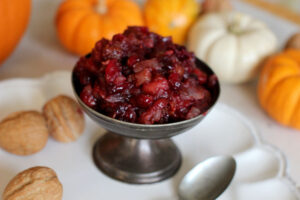Looking forward to cranberry filled Thanksgiving
By Ann Marie Cain
Winnebago-Boone Farm Bureau Manager
BOONE COUNTY – One of the traditional sides to Thanksgiving dinner is the cranberry sauce. Some are used to the round red slices of cranberry sauce served from a can. Others serve a homemade cranberry sauce that resembles a cranberry salsa. My favorite way to enjoy cranberries is to sip a warm cup of my great grandmother’s cranberry tea.
No matter the recipe, cranberries bless our table over the holidays.
Here are some interesting and fun facts about cranberries provided by The Cranberry Institute.
Cranberry, blueberry, and the Concord grape are the only three native North American fruits that are commonly cultivated.
Henry Hall, a Revolutionary War veteran, planted the first commercial cranberry bed in Dennis Massachusetts in 1816.
While commercial farms exist in nearly a dozen states, Wisconsin, Massachusetts, New Jersey, Oregon, Washington, and the Canadian provinces of British Columbia and Québec account for most of the production worldwide. Production is also expanding in Chile.
In 2012, a total of 1.13 billion pounds of cranberries were produced in the U.S., Canada and Chile.
It is a common misconception that cranberries are grown in water. Water is used during harvest to float the fruit for easier collection, and during the winter months to protect the plants from freezing and desiccation. The rest of the year the fruit is grown on dry beds.
The American cranberry is a low-growing, vining, woody perennial plant with small, alternate, oval leaves. The plant produces horizontal stems or runners up to six feet (two meters) long. Short vertical branches two to eight inches (five to 20 centimeters) in height, called uprights, grow from buds on the runners and produce both vegetative and fruit buds. Each fruit bud may contain as many as seven flowers.
Drinking eight to 16 ounces of cranberry juice cocktail each day is recommended to maintain urinary tract heath and prevent urinary tract infections.
Healthy cranberry recipes can be found at www.uscranberries.com.
Cranberries freeze very well either whole or sliced. When sealed in an airtight container, frozen cranberries will keep for nearly a year.
Holiday non-perishables food drive
The Winnebago Boone Farm Bureau Young Leaders will be hosting a non-perishables food drive through Friday, Dec. 18. Donations of can goods and non-perishable items may be dropped off at the Winnebago-Boone Farm Bureau office located at 1925 S. Meridian Road in Rockford, Monday through Friday from 8 a.m. to 4:30 p.m.
All donations will be given to the local food pantries in Boone and Winnebago Counties. Don’t forget to toss in a can of cranberry sauce.
Hope you have a safe and Happy Thanksgiving!



